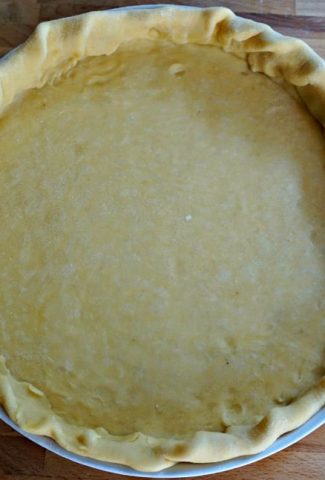
What is Pastry Crust?
As there are many different names to describe the same pastry crust, it can be confusing to most of us when reviewing recipes. A new baker may think there are actually dozens of different types of pastry or pie dough. In fact, however, the ingredients for a flaky pie crust and a mealy pie crust are mostly the same.
It’s the size of the fat in the dough that will determine if the dough will bake into a flaky or mealy pie crust. Larger pieces of fat left in the dough will generally cause the baked result to be more flaky. So if you want to prepare a more flaky crust, stop mixing the flour with the fat (butter, oil, or shortening) when the lumps of mixed dough are about the size of a pea. If you mix the flour and fat until you have a more fine mixture, the fat will be spread more uniformly and cause the baked crust to be more dense and crumbly. Many variations of crust between flaky and mealy exist, making it even more confusing for all of us.
In the United States the recipe described below would be for a pastry crust or pie crust, while in the United Kingdom it would be customarily known as a shortcrust and in France a pâte brisée. Different names again for a similar result.
This Pastry Crust recipe can be used for all occasions!
I have tweaked other pastry crust recipes to come up with one recipe that has never let me down! I prepare it as described in the recipe below for savory dishes, such as quiches, appetizers, small or normal-sized hand-held pies, or anything else for which you’d use a pastry crust.
Yet, if you want a pastry crust for a dessert or sweet dish, just add an extra tablespoon or two to the recipe and follow all other instructions. Now, you’re ready for pies and other sweet delicacies! You can add up to 1 1/2 ounces / 50 grams of ground nuts to your recipe by substituting the same quantity of flour and reducing the amount of butter used in the recipe by about 1 teaspoon / 10 grams.
This pastry crust recipe usually results in a crust that is between mealy and flaky. In short, it’s a universal dough that can be used for many occasions.
You will find below the instructions for making this dough by hand and by food processor. I used to prepare my dough by hand (because I love the kneading part). Recently, however, I’ve been preparing it by a food processor and do not notice a difference. If anything, the dough made with a food processor is more consistently the same than when I do it by hand.
Feel free to create your own special crusts by adding a teaspoon of any herbs or spices that would complement your dish. The exact quantity of herbs or spices will depend if they are fresh or dried and the type you use, as some are stronger than others.
I will be posting other recipes for crusts that are vegan and /or do not use butter. Keep your eye out for these recipes.
I hope you will enjoy this recipe. Please give me your feedback in the space below as I’m always interested in hearing your suggestions.
Pastry Crust: Pâte Brisée
Ingredients
- 225 g flour
- 110 g butter
- 1/4 tsp salt
- 1 tbsp sugar for sweet dishes you can add any kind of sugar, even brown, if you want.
- 1 egg see note for use of egg yolk and white separately
- 1 tbsp white vinegar
- 4-7 tbsp cold ice water (I usually use 5)
Instructions
By food processor
- Prepare the dough a little in advance since it must sit in the refrigerator about 30 minutes before rolling out.
- Start by mixing the flour, salt, and sugar. Cut the butter in small cubes and add to the flour mixture.
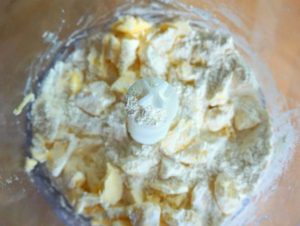
- Mix the butter with the flour until you get a grainy texture such as cornmeal. In a food processor this usually takes about 10 seconds.
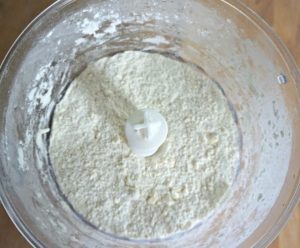
- Add the liquid ingredients (water, white vinegar and egg yolk*) into the dry mixture and mix until you get a smooth dough. In a food processor this usually takes about 30 seconds. Wait until the dough forms one piece and starts to pull away from the sides of the bowl. Remove the dough from the bowl and knead a couple times with your hands on a clean surface with a little flour. If you are able to knead without the dough sticking to your hands, the dough is ready. It should feel smooth in your hands.
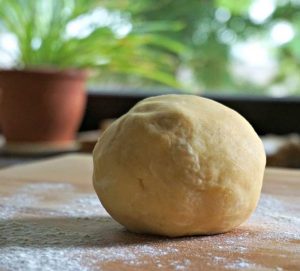
By hand
- Prepare the dough a little in advance since it must sit in the refrigerator about 30 minutes before rolling out.
- Start by mixing the flour (keep about 1/4 cup for mixing/kneading stage), salt, and sugar. Cut the butter in small cubes and add to the flour mixture. Mix the butter with the flour until you get a grainy texture such as cornmeal.
- Add the liquid ingredients (water, white vinegar and egg yolk*) into the dry mixture and mix until you get a smooth dough. If you need, add some of the reserved flour and mix some more. Continue this process (adding flour and mixing) until the dough forms one piece and starts to pull away from the sides of the bowl. Remove the dough from the bowl and knead a couple times with your hands on a clean surface with a little flour. If you are able to knead without the dough sticking to your hands, the dough is ready. It should feel smooth in your hands.
By food processor and by hand
- Wrap the dough in plastic wrap and put in the refrigerator at least 20 minutes. You can let this sit a few hours if you want to make ahead of time. I've used dough up to 2-3 days after it had been made. See below for common instructions for hand and food processor.
- While the dough is in the refrigerator I usually prepare the filling (see below) and preheat the oven to 190 C / 375 F.
- Remove the dough and roll out on a floured smooth surface (I use a very large cutting board). I usually remove a small part of the dough (about 1/3rd) as this will probably not be needed for your quiche. This extra piece can be used to fix any wholes in the rolled-out dough or for something else. Roll the dough until the desired thickness (about the thickness of a rim of a coffee cup). Try not to roll too thin.
- Transfer the dough to your pan. If you are worried about your dish not coming out after being baked, you can line the pan with cooking paper before putting in the dough. Prepare the rim of your dough by turning it over the rim (from outside to inside) and use your thumb to pinch the dough around the rim of the pan (with some space between pinches). Brush the entire dough with the unused egg white from the dough. This step is important so the liquid filling does not make your dough soggy. Prick your dough in several places with the tines of a fork.

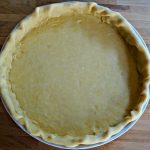
Is it tablespoons or teaspoons you mean? It seems to be a lot of liquid for 8oz of flour.
Tablespoons, Erith.